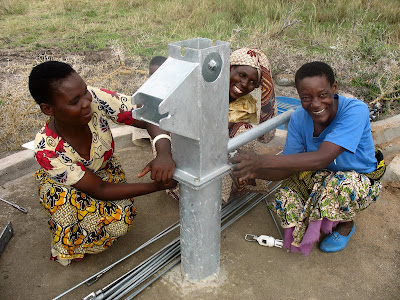We've launched a "Pig Campaign" this holiday season to raise funds to purchase pigs for women's income-generation in Karatu District. Our goal is to buy 110 pigs -- 90 female and 20 male -- and distribute them to 90 women in the communities of Rhotia Khainam, Kilima Tembo and Kambi ya Simba. Cdn $70 per pig includes purchase, transport, training, and follow-up and monitoring by CPAR field staff.
Women’s income-generating is an important component of CPAR’s Food Security Project. Our rural women partners want livestock to generate income – specifically pigs and dairy goats. Before they receive the pigs, we train the women in pig husbandry – how to care for the pigs, what to feed them, how to prevent and treat conditions like worms and foot & mouth disease – and the women are required to build a simple pig house out of locally available burnt bricks or thatch.
Each woman receives one female pig, and the male pig is shared among five households or so, depending on their geographical location. The gestation period of a pig is 114 days – poetically 3 months, 3 weeks and 3 days. One litter is usually 8 to 12 piglets, and pigs can have 2 or even 3 litters in one year. One 90 kg 8-month old pig can fetch Tsh 270,000 (about Cdn $260), and they are immensely marketable in Karatu, Arusha and as far away as Dar es Salaam. Pork is popular!
CPAR's “Pay it Forward” principle requires each woman recipient to pass on 2 female pigs and training to two additional women. Considering that the average annual income of many households is only Cdn $288, pigs are an excellent boost to household cash. And, it's a well known fact that when women have access to cash it goes to support children's education, buy food for the household and improve the health of the family.
Our goal is to raise Cdn $7,700. Please visit CPAR's Face of Giving website today to purchase a pig and put cash in the hands of women.
| This little piggy's going to market... |
Women’s income-generating is an important component of CPAR’s Food Security Project. Our rural women partners want livestock to generate income – specifically pigs and dairy goats. Before they receive the pigs, we train the women in pig husbandry – how to care for the pigs, what to feed them, how to prevent and treat conditions like worms and foot & mouth disease – and the women are required to build a simple pig house out of locally available burnt bricks or thatch.
| Nderingo with Rebekah Lazaro and her pig |
CPAR's “Pay it Forward” principle requires each woman recipient to pass on 2 female pigs and training to two additional women. Considering that the average annual income of many households is only Cdn $288, pigs are an excellent boost to household cash. And, it's a well known fact that when women have access to cash it goes to support children's education, buy food for the household and improve the health of the family.
Our goal is to raise Cdn $7,700. Please visit CPAR's Face of Giving website today to purchase a pig and put cash in the hands of women.




